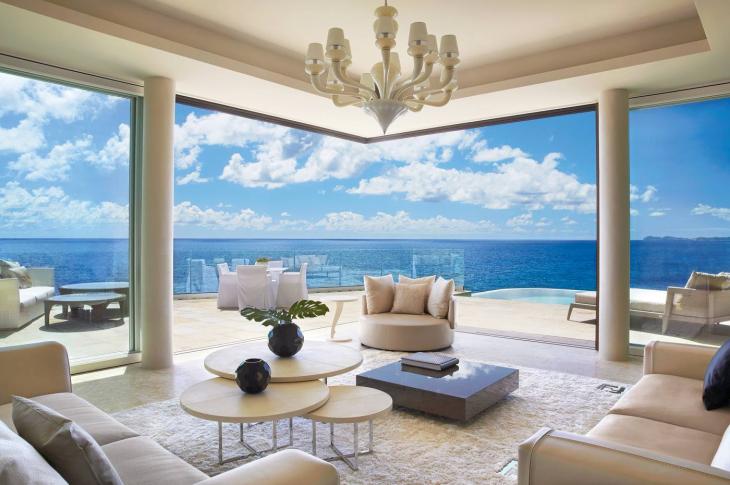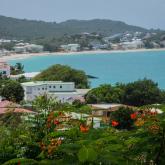
Though it is summed up, in simple terms as “The Caribbean”, the region is an absolutely vast archipelago of 7,000 islands each lapped by the warm waters of the Caribbean Sea. Due to its size, the region is subdivided into a few distinct areas: the Lucayan Archipelago, the Greater Antilles, the Lesser Antilles and the ABC Islands. The Caribbean region is actually 13 sovereign states and 17 dependent territories, which stretches across more than 1.06 million square miles. Primarily located between North America and South America, the Caribbean’s predominant languages are English, Spanish, French, Dutch and Antillean creole. Each island boasts its own unique geological character and landscape, from volcanic rock, scrub and limestone to coral, rainforest and exotic blooms.
Key islands for investment by overseas buyers that have a long-standing popularity with British buyers, include Barbados, Barbuda and Antigua, St Lucia, Trinidad and Tobago and The Bahamas. The variety of property on the market in the Caribbean is as wide as your imagination. From villas with million dollar price tags and A-list neighbours, to simple but beautiful apartments with stunning Caribbean views.

Barbados (Windward Isles)
A loyal celebrity crowd have long favoured Barbados - and this is the island to pick if you are looking for a show-biz scene. Barbados is often referred to as “Little Britain” due to its strong historical ties to the U.K. It was first settled by the British in 1627 and there are telltale reminders of this all across the island. Since then, Barbados has transformed itself into a dream vacation destination with a well-heeled crowd. With an area of 167 square miles, the island has a width of approximately 14 miles and a length of more than 21 miles. Most of the holiday resorts are on the west coast where the land is curvaceous with the highest point around 1,120 feet.
Some of the palatial mansions here may be sixty or 70 years old but they have been beautifully maintained and remodelled. Even older still are the handsome colonial houses built around neat paved courtyards, adorned with flower-filled planters and intricate ironwork. Luxurious villas in Barbados fiend to be high-spec with smart-tech kitchens, swimming pools and state of the art Jacuzzis. The island has a limited portfolio of available smaller houses - an affordable option for life on Barbados, for those who don’t have a multi-million-dollar bank balance and a opulent pad at Sandy Lane Beach.
Barbuda and Antigua (Lesser Antilles)
With its location off the coast of South America and east-southeast of Puerto Rico, the islands of Antigua and Barbuda famously boast 365 beaches - one for each day of the year. With long-standing historical links to Britain, the island of Antigua warmly welcomes expatriate investor-buyers of property on its shores. Not only does it offer enticing tax incentives, and a safe and politically steady culture, owners may even benefit from the citizenship by investment program (CIP) if they reside in Antigua for more than 35 days each year.
English is the primary language and all the major attractions, luxury resorts and the sailing scene is located with easy access to the capital city, St. John’s. The islands are a constitutional monarchy, with a government based on the English model. It is headed by Queen Elizabeth II and led by a prime minister and parliament. Enter a civic building, a school or a town hall and there will be a portrait of the Queen on the wall.
Real estate prices today are taking time to recover from the lows of the housing crisis a decade ago. However, the country has long-attracted overseas buyers thanks to its scenic beauty and untouched beaches. So while the country itself is sparsely populated, demand for its property is high. Popular areas with foreign investors include: Jolly Harbour, English Harbour, Jumby Bay, NonSuch Bay, Sugar Ridge, Tamarind Hills, and the residential areas just north of St. John’s, the capital city.

St Lucia (Windward Isles)
After a dramatic slump during the global economic woes of 2010, St Lucia's property market has been perking up nicely since 2014. Biggest areas of growth centre on properties aimed at the expatriate market, especially mid-priced entry level villas. British, American and Canadian buyers lead the way in taking advantage of all-time low prices – sometimes 15 to 25 per cent off the listing price of new houses and condominiums in both the north and south areas of St. Lucia.
Entry level properties start at around US$166,000, while villas in high-end resorts can command upwards of US$9 million. Notable for featuring a marina or a top-notch golf course as a key selling point, many of the best addresses include high-specification private suites with anchorage or unrestricted tee times. Tourism is the driver behind property sales in St. Lucia and it represents a much smaller market than countries like Barbados and Antigua. Hailed as the fastest growing tourism destination in the region in 2017 by the Caribbean Tourism Organization, arrivals in St. Lucia are climbing each year (currently 1.1 million). More than 850 new hotel rooms have been added to the island's inventory including those under the Fairmont, Hilton and the Ritz Carlton brand.
Trinidad and Tobago
Foreign homebuyers in Trinidad and Tobago come mainly from Britain, Germany, the United States and Canada. In Tobago, the most desirable addresses are those close to the islands finest soft-sand beaches. In Trinidad, the most attractive locations to rent or buy are the upscale apartment complexes in the Port of Spain suburbs of Westmoorings and Goodwood Park and the luxurious gated communities of Bayside Towers, The Greens and Maraval Valley.
Unlike many of its Caribbean neighbours, Trinidad and Tobago boast considerable wealth due to its natural resources. It doesn’t rely on tourism, but depends heavily on oil and gas production. Until a few years ago, property was a booming business too - but a newly introduced property tax of 3 per cent on residential property and 5 per cent on commercial property has seen Trinidad and Tobago’s real estate sector stall. Because tourism isn’t a pivotal part of the economy here, the country features huge expanses of pristine, virtually untouched wilderness. A trio of mountain ranges sprawl across the country, affording plenty of opportunities to hike, bike and walk bird-filled rural trails.
English is the primary language, however the Trinidad and Tobago population is incredibly ethnically diverse. Spanish is spoken in Port of Spain and a Caribbean dialect of Hindi is also spoken in some areas as well as French and Chinese.
The Bahamas
Though technically in the North Atlantic Ocean, not the Caribbean Sea, the Bahamas are located north of the Greater Antilles and southeast of Florida. As an honorary member of the region, the Bahamas is formed of thousands of cays (coral reef islands) of which most are uninhabited. Only a handful of the larger islands get any real attention from tourists - the busiest is, by far, New Providence Island. The capital Nassau, is home to the world-famous Atlantis resort, a large number of bars and restaurants. Grand Bahama is best known for its amazing underwater cave systems. Other smaller islands are renowned for their wildlife, birds and underwater coral gardens. Most island landscapes in the region are long, flat coral reef formations. Smatterings of small, rounded hills appear here and there in some areas - the highest being .Mt. Alvernia at 63 meters high.
Named from the Spanish for “shallow water,” it is the diving, sailing and water-sports of the Bahamas that has driven its tourist economy since the islands won independence from the U.K. in 1973. Since then The Bahamas has worked hard to nurture a stable and attractive investment climate. Today the Government promotes its skilled professional workforce, stable economy, sound legal framework, modern infrastructure, proximity to key markets and tax incentive to attract inward investment from overseas. It has redeveloped the country’s principal airport, which is the largest public sector project ever undertaken in The Bahamas. Another major project has been the deepening of Nassau Harbour to accommodate the world’s largest passenger vessels. Roads have been built, upgraded and extended and there is a new cargo port just outside the City of Nassau. The islands have attracted the hotel brands of Morgans, Rosewood and Hyatt while golfers Tiger Woods and Ernie Els have lent their names to exclusive high-end residential resorts. The proximity of The Bahamas to the United States has ensure the islands are popular with US buyers looking for a second home. On the 29 inhabited islands, luxurious condominiums, estate homes or bespoke builds are just some of the high end choices. And, of course, there is also the option of a private island. The Bahamas is well served by a network of domestic and international airlines which provide direct flights from all major international cities. Buying conditions are relaxed: overseas investors may acquire residential properties of up to two acres without prior government approval. The Bahamas has no restrictions on current account transactions, nor any restrictions on the repatriation of profits. Additionally, persons who purchase a home in The Bahamas valued at $1.5 million or more may receive accelerated consideration of their application for Permanent Residency - processed within a period of 21 days.





